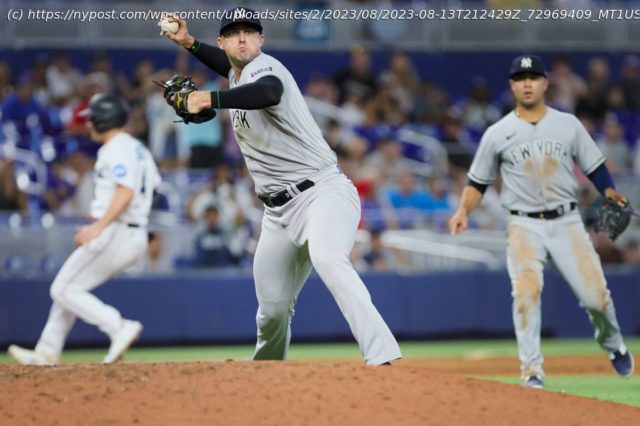I did a deep dive into what the New York Yankees should do in the big picture and long term with Clay Holmes, who can be a free agent after next season.
I figured I would take you behind the curtain.
I appreciate you being a member of Sports+, and I want to give you what you cannot receive in the newspaper, which leads to this long, in-depth column that I must deliver on Monday so it is there for you on Tuesday morning.
But because of the length, it is difficult to do all the work on Monday, especially a Monday such as this week, when I was doing TV at the MLB Network during the day and then covering the Pirates-Mets game at night. So when I think of items I want to explore, I try to knock out a few parts of the column early.
So this Sunday morning, I did a deep dive into what the Yankees should do in the big picture and long term with Clay Holmes, who can be a free agent after next season.
Now, this kind of broke one of my cardinal rules. When young reporters ask for advice, one of the pieces I give is: Don’t write about relief pitching for the early edition of the paper.
The early-edition article is written before a night game begins, so the reporter is blind to any details of the game. So if, for example, you write about how great a reliever is going and he blows the game, a reader gets the paper in the morning knowing the outcome and wondering why you stupidly wrote so glowingly about a player who failed miserably. Better just to avoid.
And here I was taking several hours Sunday morning to research and write on Holmes. But he had been so good since May 6 (three runs, 34 1/3 innings, 0.78 ERA, .454 OPS against) and this was an issue I had wanted to tackle for a while. So I just hoped he either wouldn’t get into the game or, if he did, he would have a clean inning.
Which led to another rule: This is why I don’t root for anything. Because ultimately I don’t care who wins or loses. I am rooting for myself. And when you root for yourself, it becomes more stark than ever that you have absolutely no control over the outcome, so just don’t waste energy on it. Yet I was at Citi Field on Sunday afternoon and watching the play-by-play results of the ninth inning in Miami as Holmes allowed five runs and blew the game.
Why am I telling you this?
Well, I thought you might like a glimpse behind the curtain. But also because I get to explain what I don’t get to explain to people who get the early edition of the paper when I have written about someone who then went out and performed to the opposite of my tone. I am going to give you the untouched version of what I assembled because even with Sunday’s collapse, I do believe the Yankees have this big-picture issue with Holmes coming.
Thanks for joining me behind the curtain. Now on with the regular portion of the show:Whose career do you got?
Brian Cashman has been getting bashed for one bad move after another as an autopsy is underway in real time to investigate why the Yankees are heading toward their most discouraging season in three decades.
I want to concentrate on one of his better moves because it involves a player who will be part of a substantial decision the Yankees have to make, perhaps as early as this offseason.
On July 26, 2021, in a transaction that hardly demanded mention on the back page, the Yankees dealt Diego Castillo and Hoy Park to the Pirates for Clay Holmes, who in four seasons with Pittsburgh had appeared in 91 games with a combined 5.57 ERA. His ERA as a reliever in 87 games was 5.25 — the worst in Pirates history for any pitcher who had appeared that often.
The Yankees tutored Holmes to abandon his curveball and throw his terrific sinker more, and the before-and-after has been startling. In 134 games in relief for the Yankees, he has a 2.18 ERA. The only relievers in Yankees history who have appeared that often with a better ERA are Hall of Famers Mariano Rivera (2.06 ERA as a reliever) and Goose Gossage (2.14).
The one area where the Yankees have excelled in recent seasons is maximizing performance out of their pen. Ian Hamilton, Michael King and Wandy Peralta — like Holmes — were minor acquisitions who have been major relief contributors.
The Yankees could believe off of that success that they can take a good arm that specifically has one dominant pitch and transform that pitcher into a quality reliever — and thus should avoid getting into the big-money, long-term deals with bullpen pieces. The end games on long pacts did not go well, after all, with Zack Britton and Aroldis Chapman.
Among the disasters that have contributed to the Yankees’ downturn this season was the decision in spring training 2019 to break general Yankees protocol and extend Aaron Hicks and Luis Severino before they reached free agency.
It could have been worse. The Yankees tried to do the same with Dellin Betances, but never really got close to a deal. Betances would hurt his shoulder near the end of that camp, then tear his Achilles in his only game that season and would never again be near the pitcher whose 2.37 ERA is fourth on that Yankees relief list behind Rivera, Gossage and Holmes.
That they are good at churning out relievers combined with lessons learned from Britton, Chapman, Hicks and Severino — and nearly Betances — could scare the Yankees away from trying to do long-term business with Holmes before his 2024 walk year.
But let’s take a step back and look at that Yankees bullpen. Peralta is a free agent after this season. He is the lone capable lefty, and the Yankees — as with lefty hitters — just have not developed lefty arms in their farm system. Is Ryan Anderson, Edgar Barclay or Matt Krook capable of taking a giant step from unknown to lead lefty? (Nick Ramirez is not a primary lefty reliever.)
So the Yankees will have to decide whether to try to retain Peralta, who has struggled with walks and against righties this season. Kenyan Middleton, who was obtained before the trade deadline, also is in his walk year.
Like Holmes, Jonathan Loaisiga will be in his walk year in 2024. He is less of a long-term candidate because of his inability to stay healthy. Tommy Kahnle will be in the second and final season of his contract. King has battled health issues and might be lining himself up to try to be a starter again. The Yankees should have Scott Effross fully healthy after Tommy John surgery, but there are always concerns about how a pitcher returns from surgery.
Albert Abreu seems to be filling the Esmil Rogers role — the Yankees holding onto an out-of-options reliever believing they could harness his big arm. The Yankees released Rogers at the trade deadline in 2015 finally convinced they couldn’t maximize him. The same probably would have happened this season with Abreu if the Yankees were able to stay close to healthy in their pitching staff. Regardless, it is hard to see him as a part of the 2024 pen, unless he becomes the pitching Joey Gallo or Josh Donaldson with this administration believing underlying metrics rather than their lying eyes.
Ron Marinaccio took a step back this season. Perhaps to work his way back into the majors, Luis Gil, who has missed this season after Tommy John surgery, can return as a hybrid reliever next season. And some of the prospect arms will fall from starting to relieving roles — with Clayton Beeter a prime candidate.
The Yankees will have to decide from all of that whether they annually will be able to construct a quality pen or whether they would be best served to have an anchor to build around. And is Holmes that anchor?
This is where we get into “whose career do you got?” in trying to find an equivalent to Holmes. I don’t think it is fellow Alabaman David Robertson, who had longevity and success (among other items, he is ninth on that all-time Yankees relief ERA list at 2.






